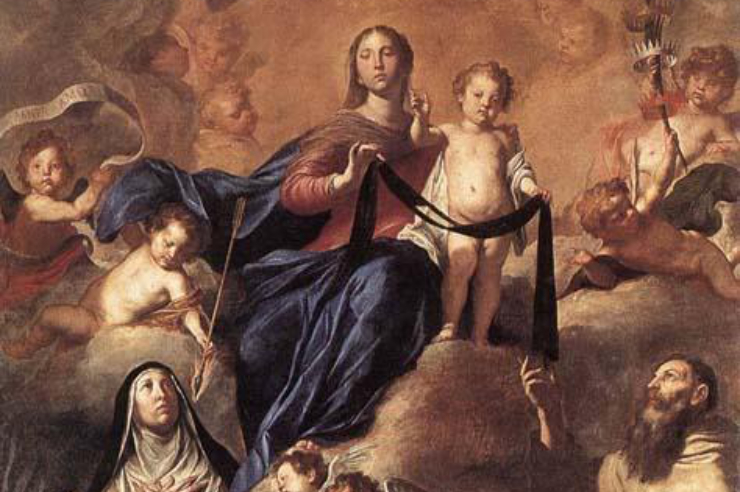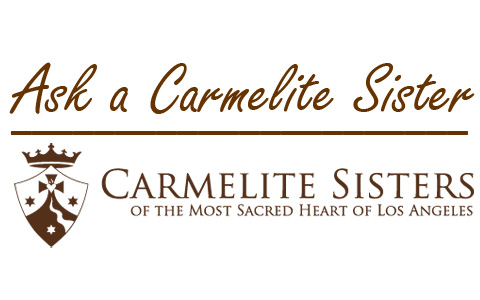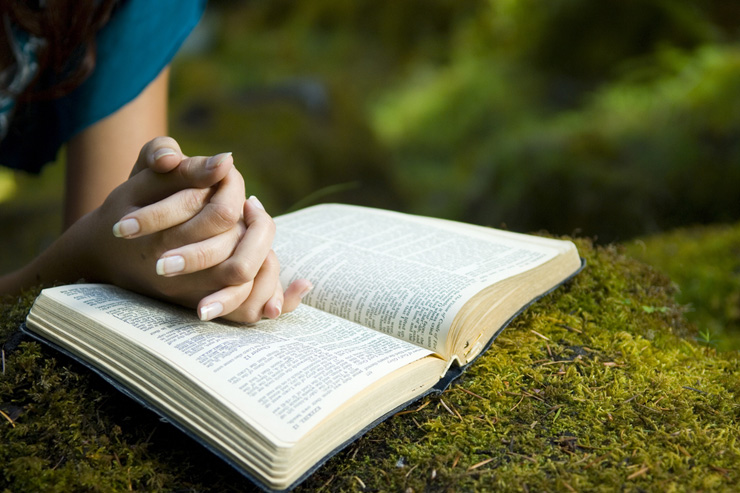
“Our Lady of Carmel” (detail including Sts Teresa of Avila and Simon Stock) by Pietro Novelli
I think Mary must have been a gardener, and not just because it seems like a thrifty use of her first century time. I imagine her kneeling down, maybe using an old cloth to cushion her knees, and getting dirt under her fingernails.
I think of her as a gardner throughout our human history too. A little trouble in France? No problem: here comes Mary with her rosary in hand and a full dose of prayer and advice.
Something’s tough in Russia? Mary’s on her way to that part of the garden, pulling a hose behind her for some special application watering.
They need help in the United States? Look, there’s Mother Mary, dressed for serious work.
A garden full of weeds looks hopeless to me, but Mary must see it as another opportunity to show her Son how much she loves Him. Weeds produce thousands—or millions?—of seeds and some of them can lay dormant in the soil for years before finding the conditions just right to bloom.
When I see my rhododendron choked by thistle and burdock and wild carrot, I want to turn around and go back in the house, drowning my gardening sorrows with a good book and leaving the work to my husband’s trusty chemicals and strength.
What does Mary see? Does she think of converting the weeds to works of mercy, leading them triumphantly through the gates of heaven to see her Son?
Perhaps Mary has a hand in tending the early seeds that will bloom later to bring beauty to her garden. Simon Stock, a hermit who later became an integral part of turning around the Carmelite Order in the thirteenth century, spent many years secluded as a hermit in the forest. He was said to have lived in a hollowed tree trunk, surviving on herbs, roots, wild apples, and water.
He spoke daily with Jesus and Mary, and it was during one of those conversations that Mary told him to find and join the Carmelites. This must have seemed bizarre to Simon, who had been in the woods for thirty-five years. But those years of frequent conversation with Jesus and Mary had prepared him to listen and obey.
I’m sure Simon must have scrutinized the Order when he found them. They were strict and serious in their asceticism, with a passionate devotion to Mary. I imagine him nodding, thinking Mary had found him the only thing that could beat a life alone with her and Jesus.
Simon had been a Carmelite for over thirty years when the 1244 migration to England occurred for the Order. He was chosen as the sixth general of the Order as the governance was moved to England with the majority of the friars. By this time, Simon was eighty-years-old, and though still alert, obviously weakened by the penances he had chosen throughout his life.
Things must have seemed just as hopeless for the Carmelites in 1244 as they do to me when I look out at my weed-covered landscaping, when they sent most of their friars to Europe. The Carmelite Order was like an abandoned garden in the thirteenth century, driven to England by the threat of Moorish invasion in the Holy Land. They didn’t have much support from the laity, and their enrollments were low. It was the kind of situation that called for divine intervention.
The Carmelite Order was founded, some think, to follow the piety of Elijah, who went to Mount Carmel to pray. They don’t have a founder in the proper sense, though they point to the hermits who settled on Mount Carmel, located in the Holy Land, as their beginning.
In the thirteenth century, they had waned to a small population, and they didn’t have any supporters. Life was risky in the Middle East, as battles between Christians and Muslims raged. This must have influenced the decision to move almost everyone to England.
I wonder if Simon felt the despair, looking at the garden of his Order, that I feel when I see my rose bushes and day lilies suffocating in dandelions and ivy and milkweed. He had dedicated his life to God, first with years living as a hermit and then in obedience through the Carmelite Order.
Did he look to heaven with tears in his eyes as he asked for help that July 16 in 1251? Was his voice cracking as he asked for a miracle to restore his Order’s supporters? Could he form words or did he just throw up his hands?
Whatever the words he used, Simon was answered by Mary herself, who appeared wearing the Carmelite habit and holding a scapular in her hand. “Receive, my beloved son,” she said, “this habit of thy Order. This shall be to thee and to all Carmelites a privilege that whosoever dies clothed in this shall never suffer eternal fire.” She assured Simon that his current problems would be solved before long.
It’s no surprise to us, over seven hundred fifty years later, that Mary was right. The Carmelite Order was transformed within a short time, with the dissenters silenced, an official ecclesiastical sanction from Pope Innocent IV, and royal protection from King Henry III. There was an increase in those interested in joining the Order, and before long it began to prosper.
Since then, the brown scapular has become a popular devotion among those devoted to Mary. It consists, in its simplest form, in wearing a small necklace, made of two rectangular pieces of brown woven wool connected by cord or string so that one of the rectangles rests on your front and the other on your back.
The conditions for enrollment include wearing the brown scapular continuously, observing chastity according to your state in life, and reciting the Little Office of the Blessed Virgin. You could choose, instead, to observe the fasts of the Church and abstain from meat on Wednesdays and Saturdays, pray five decades of the Rosary, or substitute some other good work (with permission of a priest for the last two).
Our Lady of Mount Carmel reminds me to strive for humility. She points out that the word “humble” is related to the Latin word “hummus,” for earth. Being down to earth, then, is being humble, and being humble is being like Mary. When I’m like Mary, my garden blooms fragrant with graces and blessings.
The Feast of Our Lady of Mount Carmel is July 16.















